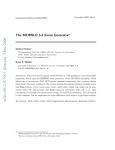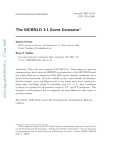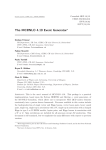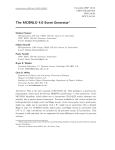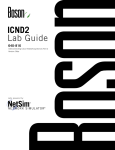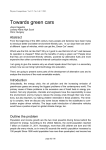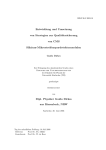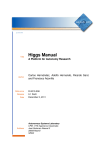Download The MC@NLO 3.3 Event Generator
Transcript
Preprint typeset in JHEP style - PAPER VERSION Cavendish–HEP–06/28 GEF–TH–19/2006 The MC@NLO 3.3 Event Generator∗ Stefano Frixione INFN, Sezione di Genova, Via Dodecaneso 33, 16146 Genova, Italy E-mail: [email protected] Bryan R. Webber Cavendish Laboratory, J.J. Thomson Avenue, Cambridge CB3 0HE, U.K. E-mail: [email protected] Abstract: This is the user’s manual of MC@NLO 3.3. This package is a practical implementation, based upon the HERWIG event generator, of the MC@NLO formalism, which allows one to incorporate NLO QCD matrix elements consistently into a parton shower framework. Processes available in this version include the hadroproduction of single vector and Higgs bosons, vector boson pairs, heavy quark pairs, single top, lepton pairs, and Higgs bosons in association with a W or Z. Spin correlations are included for all processes except ZZ and W Z production. This document is self-contained, but we emphasise the main differences with respect to previous versions. Keywords: QCD, Monte Carlo, NLO Computations, Resummation, Hadronic Colliders. ∗ Work supported in part by the UK Particle Physics and Astronomy Research Council. Contents 1. Generalities 1.1 Mode of operation 1.2 Package files 1.3 Working environment 1.4 Source and running directories 1 2 5 6 7 2. Prior to running 2.1 Parton densities 7 7 3. Running 3.1 Event file 3.2 Decays 3.3 Results 8 9 10 10 4. Script variables 11 A. Version changes A.1 From MC@NLO A.2 From MC@NLO A.3 From MC@NLO A.4 From MC@NLO A.5 From MC@NLO A.6 From MC@NLO A.7 From MC@NLO 14 14 14 15 15 15 16 16 version version version version version version version 1.0 2.0 2.1 2.2 2.3 3.1 3.2 to to to to to to to version version version version version version version 2.0 2.1 2.2 2.3 3.1 3.2 3.3 B. Running the package without the shell scripts B.1 Creating the executables B.2 The input files 17 17 18 1. Generalities In this documentation file, we briefly describe how to run the MC@NLO package, implemented according to the formalism introduced in ref. [1]. When using MC@NLO, please cite refs. [1, 2]; if single-top events are generated, please also cite ref. [3]. The production processes now available are listed in table 1. The process codes IPROC will be explained below. H1,2 represent hadrons (in practice, p or p̄). The treatment of (undecayed) vector boson pair production within MC@NLO has been described in ref. [1], that of heavy –1– quark pair production in ref. [2]. The NLO matrix elements for these processes have been taken from refs. [4, 5, 6, 7]. The information given in refs. [1, 2] allows the implementation in MC@NLO of any production process, provided that the formalism of refs. [8, 9] is used for the computation of cross sections to NLO accuracy. For specific information on single-top production, see ref. [3]. The matrix elements for Standard Model Higgs, single vector boson, lepton pair, associated Higgs, and single-top production have been taken from refs. [10, 11], ref. [12], ref. [13], ref. [14], and ref. [15] respectively. This documentation refers to MC@NLO version 3.3 (previous versions 1.0, 2.0, 2.2, 2.3, 3.1, and 3.2 are described in refs. [16, 17, 18, 19, 20, 21] respectively). Decay angular correlations due to spin correlations in top-pair and single-top production [22] have been added since version 3.2; Higgs production (IPROC=–1600–ID) now features a more sophisticated matching procedure [23] which improves the predictions for the pT spectra of the accompanying jets. For precise details of version changes, see app. A.1-A.7. 1.1 Mode of operation In the case of standard MC, a hard kinematic configuration is generated on a event-byevent basis, and it is subsequently showered and hadronized. In the case of MC@NLO, all of the hard kinematic configurations are generated in advance, and stored in a file (which we call event file – see sect. 3.1); the event file is then read by HERWIG, which showers and hadronizes each hard configuration. Since version 2.0, the events are handled by the “Les Houches” generic user process interface [24] (see ref. [2] for more details). Therefore, in MC@NLO the reading of a hard configuration from the event file is equivalent to the generation of such a configuration in the standard MC. The signal to HERWIG that configurations should be read from an event file using the Les Houches interface is a negative value of the process code IPROC; this accounts for the negative values in table 1. In the case of heavy quark pair, Higgs, Higgs in association with a W or Z, and lepton pair (through Z/γ ∗ exchange) production, the codes are simply the negative of those for the corresponding standard HERWIG MC processes. Where possible, this convention will be adopted for additional MC@NLO processes. Consistently with what happens in standard HERWIG, by subtracting 10000 from IPROC one generates the same processes as in table 1, but eliminates the underlying event1 . Higgs decays are controlled in the same way as in HERWIG, that is by adding -ID to the process code. The conventions for ID are the same as in HERWIG, namely ID = 1 . . . 6 for uū . . . tt̄; 7 . . . 9 for e+ e− . . . τ + τ − ; 10, 11 for W + W − , ZZ; and 12 for γγ. Furthermore, ID = 0 gives quarks of all flavours, and ID = 99 gives all decays. Process codes IPROC=−1360−IL and −1370−IL do not have an analogue in HERWIG; they are the same as −1350−IL, except for the fact that only a Z or a γ ∗ respectively is exchanged. The value of IL determines the lepton identities, and the same convention as in HERWIG is adopted: IL=1, . . . , 6 for lIL = e, νe , µ, νµ , τ, ντ respectively. At variance with HERWIG, IL cannot be set equal to zero. Process codes IPROC=−1460−IL and −1470−IL are the analogue of HERWIG 1450+IL; in HERWIG either W + or W − can be produced, 1 The same effect can be achieved by setting the HERWIG parameter PRSOF = 0. –2– whereas MC@NLO treats the two vector bosons separately. For these processes, as in HERWIG, IL=1, 2, 3 for lIL = e, µ, τ , but again the choice IL = 0 is not allowed. IPROC –1350–IL –1360–IL –1370–IL –1460–IL –1470–IL –1396 –1397 –1497 –1498 –1600–ID –1705 –1706 –1706 –2000–IC –2000–IC –2001–IC –2001–IC –2004–IC –2004–IC –2600–ID –2600–ID –2600–ID –2600–ID –2700–ID –2700–ID –2850 –2850 –2860 –2870 –2880 IV 1 1 -1 -1 0 0 IL1 IL2 Spin X X X X X × × × × 7 i 7 i 7 i 7 i 7 i 7 i 7 i 7 i 7 7 7 7 j × X × X × X × X × X × X × X × X × × × 7 j 7 7 7 Process H1 H2 → (Z/γ ∗ →)lIL ¯lIL + X H1 H2 → (Z →)lIL ¯lIL + X H1 H2 → (γ ∗ →)lIL ¯lIL + X + H1 H2 → (W + →)lIL νIL + X − − H1 H2 → (W →)lIL ν̄IL + X P H1 H2 → γ ∗ (→ i fi f¯i ) + X H1 H2 → Z 0 + X H1 H2 → W + + X H1 H2 → W − + X H1 H2 → H 0 + X H1 H2 → bb̄ + X H1 H2 → tt̄ + X H1 H2 → (t →)bli+ νi (t̄ →)b̄lj− ν̄j + X H1 H2 → t/t̄ + X H1 H2 → (t →)bli+ νi /(t̄ →)b̄li− ν̄i + X H1 H2 → t̄ + X H1 H2 → (t̄ →)b̄li− ν̄i + X H1 H2 → t + X H1 H2 → (t →)bli+ νi + X H1 H2 → H 0 W + + X H1 H2 → H 0 (W + →)li+ νi + X H1 H2 → H 0 W − + X H1 H2 → H 0 (W − →)li− ν̄i + X H1 H2 → H 0 Z + X H1 H2 → H 0 (Z →)li ¯li + X H1 H2 → W + W − + X H1 H2 → (W + →)li+ νi (W − →)lj− ν̄j + X H1 H2 → Z 0 Z 0 + X H1 H2 → W + Z 0 + X H1 H2 → W − Z 0 + X Table 1: Processes implemented in MC@NLO 3.3. H 0 denotes the Standard Model Higgs boson and the value of ID controls its decay, as described in the HERWIG manual and below. The values of IV, IL, IL1 , and IL2 control the identities of vector bosons and leptons, as described below. In single-t production, the value of IC controls the production processes, as described below. IPROC– 10000 generates the same processes as IPROC, but eliminates the underlying event. A void entry indicates that the corresponding variable is unused. The ‘Spin’ column indicates whether spin correlations in vector boson or top decays are included (X), neglected (×) or absent (void entry). Spin correlations in Higgs decays are included by HERWIG (e.g. in H 0 → W + W − → l+ νl− ν̄). –3– The lepton pair processes IPROC=−1350−IL, . . ., −1470−IL include spin correlations when generating the angular distributions of the produced leptons. However, if spin correlations are not an issue, the single vector boson production processes IPROC= −1396,−1397,−1497,−1498 can be used, in which case the vector boson decay products are distributed according to phase space. There are a number of other differences between the lepton pair and single vector boson processes. The latter do not feature the γ–Z interference terms. Also, their cross sections are fully inclusive in the final-state fermions resulting from γ ∗ , Z or W ± . The user can still select a definite decay mode using the variable MODBOS (see sect. 3.2), but the relevant branching ratio will not be included automatically by MC@NLO. In the case of γ ∗ production, the branching ratios are Ci qi2 /(20/3), qi being the electric charge (in units of the positron charge) of the fermion i selected through MODBOS, and Ci = 1 for leptons and P 3 for quarks. Notice that 20/3 = i Ci qi2 , the sum including all leptons and quarks except the top. Thus, the total rate predicted by MC@NLO in the case of lepton pair production can also be recovered by multiplying the corresponding single vector boson total rate by the relevant branching ratio. In NLO computations for single-top production, it is customary to distinguish between three production mechanisms, conventionally denoted as s channel, t channel, and W t mode. In version 3.3, only the former two are implemented. The user can generate them either separately, by setting IC=10 and IC=20 for s- and t-channel production respectively, or together, by setting IC=0. For example, according to table 1, t-channel single-t̄ events will be generated by entering IPROC=−2021. In the case of vector boson pair production, the process codes are the negative of those adopted in MC@NLO 1.0 (for which the Les Houches interface was not yet available), rather than those of standard HERWIG. Furthermore, in the case of tt̄, single-t, H 0 W ± , H 0 Z and W + W − production, the value of IPROC alone may not be sufficient to fully determine the process type (including decay products), and new variables IV, IL1 , and IL2 have been introduced (see table 1). The variables IL1 and IL2 can take the same values as IL relevant to lepton pair production (notice, however, that in the latter case IL is not an independent variable, and its value is included via IPROC); in addition, ILα =7 implies that spin correlations for the decay products of the corresponding particle are not taken into account, as indicated in table 1. More details are given in sect. 3.2. Apart from the above differences, MC@NLO and HERWIG behave in exactly the same way. Thus, the available user’s analysis routines can be used in the case of MC@NLO. One should recall, however, that MC@NLO always generates some events with negative weights (see refs. [1, 2]); therefore, the correct distributions are obtained by summing weights with their signs (i.e., the absolute values of the weights must NOT be used when filling the histograms). With such a structure, it is natural to create two separate executables, which we improperly denote as NLO and MC. The former has the sole scope of creating the event file; the latter is just HERWIG, augmented by the capability of reading the event file. –4– 1.2 Package files The package consists of the following files: • Shell utilities MCatNLO.Script MCatNLO.inputs Makefile • Utility codes MEcoupl.inc alpha.f dummies.f linux.f mcatnlo date.f mcatnlo hbook.f mcatnlo helas2.f mcatnlo hwdummy.f mcatnlo int.f mcatnlo lhauti.f mcatnlo libofpdf.f mcatnlo mlmtolha.f mcatnlo mlmtopdf.f mcatnlo pdftomlm.f mcatnlo str.f mcatnlo uti.f mcatnlo uxdate.c sun.f trapfpe.c • General HERWIG routines mcatnlo hwdriver.f mcatnlo hwlhin.f • Process-specific codes mcatnlo hwanbtm.f mcatnlo hwanhgg.f mcatnlo hwanllp.f mcatnlo hwantop.f mcatnlo hwanstp.f mcatnlo hwansvb.f mcatnlo hwanvbp.f mcatnlo hwanvhg.f mcatnlo hgmain.f mcatnlo hgxsec.f –5– mcatnlo llmain.f mcatnlo llxsec.f mcatnlo qqmain.f mcatnlo qqxsec.f mcatnlo sbmain.f mcatnlo sbxsec.f mcatnlo stmain.f mcatnlo stxsec.f mcatnlo vbmain.f mcatnlo vbxsec.f mcatnlo vhmain.f mcatnlo vhxsec.f hgscblks.h hvqcblks.h llpcblks.h stpcblks.h svbcblks.h vhgcblks.h These files can be downloaded from the web page: http://www.hep.phy.cam.ac.uk/theory/webber/MCatNLO The files mcatnlo hwanxxx.f, which appear in the list of the process-specific codes, are sample HERWIG analysis routines. They are provided here to give the user a ready-to-run package, but they should be replaced with appropriate codes according to the user’s needs. In addition to the files listed above, the user will need a version of the HERWIG code [25, 26, 27]. As stressed in ref. [1], for the MC@NLO we do not modify the existing (LL) shower algorithm. However, since MC@NLO versions 2.0 and higher make use of the Les Houches interface, first implemented in HERWIG 6.5, the version must be 6.500 or higher. On most systems, users will need to delete the dummy subroutines UPEVNT, UPINIT, PDFSET and STRUCTM from the standard HERWIG package, to permit linkage of the corresponding routines from the MC@NLO package. As a general rule, the user is strongly advised to use the most recent version of HERWIG (currently 6.510 – with versions lower than 6.504 problems can be found in attempting to specify the decay modes of single vector bosons through the variable MODBOS. Also, crashes in the shower phase have been reported when using HERWIG 6.505, and we therefore recommend not to use that version). 1.3 Working environment We have written a number of shell scripts and a Makefile (all listed under Shell utilities above) which will simplify the use of the package considerably. In order to use them, the computing system must support bash shell, and gmake2 . Should they be unavailable on the user’s computing system, the compilation and running of MC@NLO requires more detailed 2 For Macs running under OSX v10 or higher, make can be used instead of gmake. –6– instructions; in this case, we refer the reader to app. B. This appendix will serve also as a reference for a more advanced use of the package. 1.4 Source and running directories We assume that all the files of the package sit in the same directory, which we call the source directory. When creating the executable, our shell scripts determine the type of operating system, and create a subdirectory of the source directory, which we call the running directory, whose name is Alpha, Sun, Linux, or Darwin, depending on the operating system. If the operating system is not known by our scripts, the name of the working directory is Run. The running directory contains all the object files and executable files, and in general all the files produced by the MC@NLO while running. It must also contain the relevant grid files (see sect. 2.1), or links to them, if the library of parton densities provided with the MC@NLO package is used. 2. Prior to running Before running the code, the user needs to edit the following files: mcatnlo hwanxxx.f mcatnlo hwdriver.f mcatnlo hwlhin.f We do not assume that the user will adopt the latest release of HERWIG (although, as explained above, it must be version 6.500 or higher). For this reason, the files mcatnlo hwdriver.f and mcatnlo hwlhin.f must be edited, in order to modify the INCLUDE HERWIGXX.INC command to correspond to the version of HERWIG the user is going to adopt. mcatnlo hwdriver.f contains a set of read statements, which are necessary for the MC to get the input parameters (see sect. 3 for the input procedure); these read statements must not be modified or eliminated. Also, mcatnlo hwdriver.f calls the HERWIG routines which perform showering, hadronization, decays (see sect. 3.2 for more details on this issue), and so forth; the user can freely modify this part, as customary in MC runs. Finally, the sample codes mcatnlo hwanxxx.f contain analysis-related routines: these files must be replaced by files which contain the user’s analysis routines. We point out that, since version 2.0, the Makefile need not be edited any longer, since the corresponding operations are now performed by setting script variables (see sect. 4). 2.1 Parton densities Since the knowledge of the parton densities (PDF) is necessary in order to get the physical cross section, a PDF library must be linked. The possibility exists to link the (now obsolete) CERNLIB PDF library (PDFLIB), or its replacement LHAPDF [28]; however, we also provide a self-contained PDF library with this package, which is faster than PDFLIB, and contains PDF sets released after the last and final PDFLIB version (8.04; most of these sets are now included in LHAPDF). A complete list of the PDFs available in our PDF library can be downloaded from the MC@NLO web page. The user may link one of the three PDF libraries; all that is necessary is to set the variable PDFLIBRARY (in the file –7– MCatNLO.inputs) equal to THISLIB if one wants to link to our PDF library, and equal to PDFLIB or to LHAPDF if one wants to link to PDFLIB or to LHAPDF. Our PDF library collects the original codes, written by the authors of the PDF fits; as such, for most of the densities it needs to read the files which contain the grids that initialize the PDFs. These files, which can be also downloaded from the MC@NLO web page, must either be copied into the running directory, or defined in the running directory as logical links to the physical files (by using ln -sn). We stress that if the user runs MC@NLO with the shell scripts, the logical links will be created automatically at run time. As stressed before, consistent inputs must be given to the NLO and MC codes. However, in ref. [1] we found that the dependence upon the PDFs used by the MC is rather weak. So one may want to run the NLO and MC adopting a regular NLL-evolved set in the former case, and the default HERWIG set in the latter (the advantage is that this option reduces the amount of running time of the MC). In order to do so, the user must set the variable HERPDF equal to DEFAULT in the file MCatNLO.inputs; setting HERPDF=EXTPDF will force the MC to use the same PDF set as the NLO code. Regardless of the PDFs used in the MC run, users must delete the dummy PDFLIB routines PDFSET and STRUCTM from HERWIG, as explained earlier. 3. Running It is straightforward to run the MC@NLO. First, edit MCatNLO.inputs and write there all the input parameters (for the complete list of the input parameters, see sect. 4). As the last line of the file MCatNLO.inputs, write runMCatNLO Finally, execute MCatNLO.inputs from the bash shell. This procedure will create the NLO and MC executables, and run them using the inputs given in MCatNLO.inputs, which guarantees that the parameters used in the NLO and MC runs are consistent. Should the user only need to create the executables without running them, or to run the NLO or the MC only, he/she should replace the call to runMCatNLO in the last line of MCatNLO.inputs by calls to compileNLO compileMC runNLO runMC which have obvious meanings. We point out that the command runMC may be used with IPROC=1350+IL, 1450+IL, 1600+ID, 1699, 1705, 1706, 2000–2008, 2600+ID, 2699, 2700+ID, 2799 to generate Z/γ ∗ , W ± , Higgs, bb̄, tt̄, single top, H 0 W or H 0 Z events with standard HERWIG (see the HERWIG manual for more details). We stress that the input parameters are not solely related to physics (masses, CM energy, and so on); there are a few of them which control other things, such as the number of events generated. These must also be set by the user, according to his/her needs: see sect. 4. –8– Two such variables are HERWIGVER and HWUTI, which were moved in version 2.0 from the Makefile to MCatNLO.inputs. The former variable must be set equal to the object file name of the version of HERWIG currently adopted (matching the one whose common blocks are included in the files mentioned in sect. 2). The variable HWUTI must be set equal to the list of object files that the user needs in the analysis routines. If the shell scripts are not used to run the codes, the inputs are given to the NLO or MC codes during an interactive talk-to phase; the complete sets of inputs for our codes are reported in app. B.2 for vector boson pair production. 3.1 Event file The NLO code creates the event file. In order to do so, it goes through two steps; first it integrates the cross sections (integration step), and then, using the information gathered in the integration step, produces a set of hard events (event generation step). Integration and event generation are performed with a modified version of the SPRING-BASES package [29]. We stress that the events stored in the event file just contain the partons involved in the hard suprocesses. Owing to the modified subtraction introduced in the MC@NLO formalism (see ref. [1]) they do not correspond to pure NLO configurations, and should not be used to plot physical observables. Parton-level observables must be reconstructed using the fully-showered events. The event generation step necessarily follows the integration step; however, for each integration step one can have an arbitrary number of event generation steps, i.e., an arbitrary number of event files. This is useful in the case in which the statistics accumulated with a given event file is not sufficient. Suppose the user wants to create an event file; editing MCatNLO.inputs, the user sets BASES=ON, to enable the integration step, sets the parameter NEVENTS equal to the number of events wanted on tape, and runs the code; the information on the integration step (unreadable to the user, but needed by the code in the event generation step) is written on files whose name begin with FPREFIX, a string the user sets in MCatNLO.inputs; these files (which we denotes as data files) have extensions .data. The name of the event file is EVPREFIX.events, where EVPREFIX is again a string set by the user. Now suppose the user wants to create another event file, to increase the statistics. The user simply sets BASES=OFF, since the integration step is not necessary any longer (however, the data files must not be removed: the information stored there is still used by the NLO code); changes the string EVPREFIX (failure to do so overwrites the existing event file), while keeping FPREFIX at the same value as before; and changes the value of RNDEVSEED (the random number seed used in the event generation step; failure to do so results in an event file identical to the previous one); the number NEVENTS generated may or may not be equal to the one chosen in generating the former event file(s). We point out that data and event files may be very large. If the user wants to store them in a scratch area, this can be done by setting the script variable SCRTCH equal to the physical address of the scratch area (see sect. 3.3). –9– 3.2 Decays MC@NLO is intended primarily for the study of NLO corrections to production cross sections and distributions; NLO corrections to the decays of produced particles are not included. As for spin correlations, the situation in version 3.3 is summarized in table 1: they are included for all processes except ZZ and W Z production3 . For the latter processes, quantities sensitive to the polarisation of produced particles are not given correctly even to leading order. For such quantities, it may be preferable to use the standard HERWIG MC, which does include leading-order spin correlations. Following HERWIG conventions, spin correlations in single-vector-boson processes are automatically included using the process codes (IPROC) relevant to lepton pair production. In order to avoid an unnecessary proliferation of IPROC values, this strategy has not been adopted in other cases (tt̄, single-t, H 0 W ± , H 0 Z, W + W − ), in which spin correlations are included if the variables IL1 and IL2 (the latter is used only in tt̄ and W + W − production) are given values ranging from 1 to 3 if the decaying particle is a W or a top, or from 1 to 6 if the decaying particle is a Z. The value of ILα determines the identity of the leptons emerging from the decay, and the same convention as in HERWIG is adopted (see the HERWIG manual and sect. 1.1). When ILα =7, the corresponding particle is left undecayed by the NLO code, and is passed as such to the MC code; the information on spin correlations is lost. However, the user can still force particular decay modes during the MC run. In the case of vector bosons, one proceeds in the same way as in standard HERWIG, using the MODBOS variables – see sect. 3.4 of ref. [26]. However, top decays cannot be forced in this way because the decay is treated as a three-body process: the W ± boson entry in HEPEVT is for information only. Instead, the top branching ratios can be altered using the HWMODK subroutine – see sect. 7 of ref. [26]. This is done separately for the t and t̄. For example, CALL HWMODK(6,1.D0,100,12,-11,5,0,0) forces the decay t → νe e+ b, while leaving t̄ decays unaffected. Note that the order of the decay products is important for the decay matrix element (NME = 100) to be applied correctly. The relevant statements should be inserted in the HERWIG main program (corresponding to mcatnlo hwdriver.f in this package) after the statement CALL HWUINC and before the loop over events. A separate run with CALL HWMODK(-6,1.D0,100,-12,11,-5,0,0) should be performed if one wishes to symmetrize the forcing of t and t̄ decays, since calls to HWMODK from within the event loop do not produce the desired result. 3.3 Results As in the case of standard HERWIG the form of the results will be determined by the user’s analysis routines. However, in addition to any files written by the user’s analysis routines, the MC@NLO writes the following files: FPREFIXNLOinput: the input file for the NLO executable, created according to the set of input parameters defined in MCatNLO.inputs (where the user also sets the string FPREFIX). Non-factorizable spin correlations of virtual origin are not included in W + W − , tt̄, and single-t production. See ref. [22]. 3 – 10 – See table 2. FPREFIXNLO.log: the log file relevant to the NLO run. FPREFIXxxx.data: xxx can assume several different values. These are the data files created by the NLO code. They can be removed only if no further event generation step is foreseen with the current choice of parameters. FPREFIXMCinput: analogous to FPREFIXNLOinput, but for the MC executable. See table 4. FPREFIXMC.log: analogous to FPREFIXNLO.log, but for the MC run. EVPREFIX.events: the event file, where EVPREFIX is the string set by the user in MCatNLO.inputs. EVPREFIXxxx.events: xxx can assume several different values. These files are temporary event files, which are used by the NLO code, and eventually removed by the shell scripts. They MUST NOT be removed by the user during the run (the program will crash or give meaningless results). By default, all the files produced by the MC@NLO are written in the running directory. However, if the variable SCRTCH (to be set in MCatNLO.inputs) is not blank, the data and event files will be written in the directory whose address is stored in SCRTCH (such a directory is not created by the scripts, and must already exist at run time). 4. Script variables In the following, we list all the variables appearing in MCatNLO.inputs; these can be changed by the user to suit his/her needs. This must be done by editing MCatNLO.inputs. For fuller details see the comments in MCatNLO.inputs. ECM The CM energy of the colliding particles. FREN The ratio between the renormalization scale, and a reference mass scale. FFACT As FREN, for the factorization scale. HVQMASS The mass (in GeV) of the top quark, except when IPROC=–(1)1705, when it is the mass of the bottom quark. In this case, HVQMASS must coincide with BMASS. xMASS The mass (in GeV) of the particle x, with x=HGG,W,Z,U,D,S,C,B,G. xWIDTH The physical (Breit-Wigner) width (in GeV) of the particle x, with x=HGG,W,Z,T for H 0 , W ± , Z, and t respectively. IBORNHGG Valid entries are 1 and 2. If set to 1, the exact top mass dependence is retained at the Born level in Higgs production. If set to 2, the mt → ∞ limit is used. xGAMMAX If xGAMMAX > 0, controls the width of the mass range for Higgs (x=H) and vector bosons (x=V1,V2): the range is MASS ± (GAMMAX × WIDTH). xMASSINF Lower limit of the Higgs (x=H) or vector boson (x=V1,V2) mass range; used only when xGAMMAX < 0. – 11 – xMASSSUP Upper limit of the Higgs (x=H) or vector boson (x=V1,V2) mass range; used only when xGAMMAX < 0. Vud CKM matrix elements, with u=U,C,T and d=D,S,B. Set VUD=VUS=VUB=0 to use values of PDG2003. Vud is only used in single-t production. AEMRUN Set it to YES to use running αem in lepton pair and single vector boson production, set it to NO to use αem = 1/137.0359895. IPROC Process number that identifies the hard subprocess: see table 1 for valid entries. IVCODE Identifies the nature of the vector boson in associated Higgs production. It corresponds to variable IV of table 1. ILxCODE Identify the nature of the leptons emerging from vector boson or top decays (x = 1, 2). They correspond to variables IL1 and IL2 of table 1. PARTn The type of the incoming particle #n, with n=1,2. HERWIG naming conventions are used (P, PBAR, N, NBAR). PDFGROUP The name of the group fitting the parton densities used; the labeling conventions of PDFLIB are adopted. Unused when linked to LHAPDF. PDFSET The number of the parton density set; according to PFDLIB conventions, the pair (PDFGROUP, PDFSET) identifies the densities for a given particle type. When linked to LHAPDF, use the numbering conventions of LHAGLUE [28]. LAMBDAFIVE The value of ΛQCD , for five flavours and in the MS scheme, used in the computation of NLO cross sections. LAMBDAHERW The value of ΛQCD used in MC runs; this parameter has the same meaning as ΛQCD in HERWIG. SCHEMEOFPDF The subtraction scheme in which the parton densities are defined. FPREFIX Our integration routine creates files with name beginning by the string FPREFIX. These files are not directly accessed by the user; for more details, see sect. 3.1. EVPREFIX The name of the event file begins with this string; for more details, see sect. 3.1. EXEPREFIX The names of the NLO and MC executables begin with this string; this is useful in the case of simultaneous runs. NEVENTS The number of events stored in the event file, eventually processed by HERWIG . WGTTYPE Valid entries are 0 and 1. When set to 0, the weights in the event file are ±1. When set to 1, they are ±w, with w a constant such that the sum of the weights gives the total NLO cross section. N.B. These weights are redefined by HERWIG at MC run time according to its own convention (see HERWIG manual). – 12 – RNDEVSEED The seed for the random number generation in the event generation step; must be changed in order to obtain statistically-equivalent but different event files. BASES Controls the integration step; valid entries are ON and OFF. At least one run with BASES=ON must be performed (see sect. 3.1). PDFLIBRARY Valid entries are PDFLIB, LHAPDF, and THISLIB. In the former two case, PDFLIB or LHAPDF is used to compute the parton densities, whereas in the latter case the densities are obtained from our self-contained faster package. HERPDF If set to DEFAULT, HERWIG uses its internal PDF set (controlled by NSTRU), regardless of the densities adopted at the NLO level. If set to EXTPDF, HERWIG uses the same PDFs as the NLO code (see sect. 2.1). HWPATH The physical address of the directory where the user’s preferred version of HERWIG is stored. SCRTCH The physical address of the directory where the user wants to store the data and event files. If left blank, these files are stored in the running directory. HWUTI This variables must be set equal to a list of object files, needed by the analysis routines of the user (for example, HWUTI=obj1.o obj2.o obj3.o is a valid assignment). HERWIGVER This variable must to be set equal to the name of the object file corresponding to the version of HERWIG linked to the package (for example, HERWIGVER=herwig65.o is a valid assignment). PDFPATH The physical address of the directory where the PDF grids are stored. Effective only if PDFLIBRARY=THISLIB. LHAPATH Set this variable equal to the name of the directory where the local version of LHAPDF is installed. LHAOFL Set LHAOFL=FREEZE to freeze PDFs from LHAPDF at the boundaries, or equal to EXTRAPOLATE otherwise. See LHAPDF manual for details. Acknowledgement Many thanks to P. Nason for contributions to the heavy quark code and valuable discussions on all aspects of the MC@NLO project, and to E. Laenen and P. Motylinski for the work done on single-t and tt̄ production. We also thank V. Drollinger and B. Quayle for testing a preliminary version of the W + W − code with spin correlations, and Y. Fang and B. Mellado for testing a preliminary version of the Higgs code in version 3.3. We are grateful for the hospitality of CERN Theory Division, where most of this work was carried out. – 13 – Appendices A. Version changes A.1 From MC@NLO version 1.0 to version 2.0 In this appendix we list the changes that occurred in the package from version 1.0 to version 2.0. • The Les Houches generic user process interface has been adopted. • As a result, the convention for process codes has been changed: MC@NLO process codes IPROC are negative. • The code mcatnlo hwhvvj.f, which was specific to vector boson pair production in version 1.0, has been replaced by mcatnlo hwlhin.f, which reads the event file according to the Les Houches prescription, and works for all the production processes implemented. • The Makefile need not be edited, since the variables HERWIGVER and HWUTI have been moved to MCatNLO.inputs (where they must be set by the user). • A code mcatnlo hbook.f has been added to the list of utility codes. It contains a simplified version (written by M. Mangano) of HBOOK, and it is only used by the sample analysis routines mcatnlo hwanxxx.f. As such, the user will not need it when linking to a self-contained analysis code. We also remind the reader that the HERWIG version must be 6.5 or higher since the Les Houches interface is used. A.2 From MC@NLO version 2.0 to version 2.1 In this appendix we list the changes that occurred in the package from version 2.0 to version 2.1. • Higgs production has been added, which implies new process-specific files (mcatnlo hgmain.f, mcatnlo hgxsec.f, hgscblks.h, mcatnlo hwanhgg.f), and a modification to mcatnlo hwlhin.f. • Post-1999 PDF sets have been added to the MC@NLO PDF library. • Script variables have been added to MCatNLO.inputs. Most of them are only relevant to Higgs production, and don’t affect processes implemented in version 2.0. One of them (LAMBDAHERW) may affect all processes: in version 2.1, the variables LAMBDAFIVE and LAMBDAHERW are used to set the value of ΛQCD in NLO and MC runs respectively, whereas in version 2.0 LAMBDAFIVE controlled both. The new setup is necessary since modern PDF sets have ΛQCD values which are too large to be supported by HERWIG. (Recall that the effect of using LAMBDAHERW different from LAMBDAFIVE is beyond NLO.) • The new script variable PDFPATH should be set equal to the name of the directory where the PDF grid files (which can be downloaded from the MC@NLO web page) are stored. At run time, when executing runNLO, or runMC, or runMCatNLO, logical links to these files will be created in the running directory (in version 2.0, this operation had to be performed by the user manually). • Minor bugs corrected in mcatnlo hbook.f and sample analysis routines. – 14 – A.3 From MC@NLO version 2.1 to version 2.2 In this appendix we list the changes that occurred in the package from version 2.1 to version 2.2. • Single vector boson production has been added, which implies new process-specific files (mcatnlo sbmain.f, mcatnlo sbxsec.f, svbcblks.h, mcatnlo hwansvb.f), and a modification to mcatnlo hwlhin.f. • The script variables WWIDTH and ZWIDTH have been added to MCatNLO.inputs. These denote the physical widths of the W and Z 0 bosons, used to generate the mass distributions of the vector bosons according to the Breit–Wigner function, in the case of single vector boson production (vector boson pair production is still implemented only in the zero-width approximation). A.4 From MC@NLO version 2.2 to version 2.3 In this appendix we list the changes that occurred in the package from version 2.2 to version 2.3. • Lepton pair production has been added, which implies new process-specific files (mcatnlo llmain.f, mcatnlo llxsec.f, llpcblks.h, mcatnlo hwanllp.f), and modifications to mcatnlo hwlhin.f and mcatnlo hwdriver.f. • The script variable AEMRUN has been added, since the computation of single vector boson and lepton pair cross sections is performed in the MS scheme (the on-shell scheme was previously used for single vector boson production). • The script variables FRENMC and FFACTMC have been eliminated. • The structure of pseudo-random number generation in heavy flavour production has been changed, to avoid a correlation that affected the azimuthal angle distribution for the products of the hard partonic subprocesses. • A few minor bugs have been corrected, which affected the rapidity of the vector bosons in single vector boson production (a 2–3% effect), and the assignment of ΛQCD for the LO and NLO PDF sets of Alekhin. A.5 From MC@NLO version 2.3 to version 3.1 In this appendix we list the changes that occurred in the package from version 2.3 to version 3.1. • Associated Higgs production has been added, which implies new process-specific files (mcatnlo vhmain.f, mcatnlo vhxsec.f, vhgcblks.h, mcatnlo hwanvhg.f), and modifications to mcatnlo hwlhin.f and mcatnlo hwdriver.f. • Spin correlations in W + W − production and leptonic decay have been added; the relevant codes (mcatnlo vpmain.f, mcatnlo vhxsec.f) have been modified; the sample analysis routines (mcatnlo hwanvbp.f) have also been changed. Tree-level matrix elements have been computed with MadGraph/MadEvent [30, 31], which uses HELAS [32]; the relevant routines and common blocks are included in mcatnlo helas2.f and MEcoupl.inc. • The format of the event file has changed in several respects, the most relevant of which is that the four-momenta are now given as (px , py , pz , m) (up to version 2.3 we had – 15 – (px , py , pz , E)). Event files generated with version 2.3 or lower must not be used with version 3.1 or higher (the code will prevent the user from doing so). • The script variables GAMMAX, MASSINF, and MASSSUP have been replaced with xGAMMAX, xMASSINF and xMASSSUP, with x=H,V1,V2. • New script variables IVCODE, IL1CODE, and IL2CODE have been introduced. • Minor changes have been made to the routines that put the partons on the HERWIG mass shell for lepton pair, heavy quark, and vector boson pair production; effects are beyond the fourth digit. • The default electroweak parameters have been changed for vector boson pair production, in order to make them consistent with those used in other processes. The cross sections are generally smaller in version 3.1 wrt previous versions, the dominant effect being the value of sin θW : we have now sin2 θW = 0.2311, in lower versions sin2 θW = 1 − m2W /m2Z . The cross sections are inversely proportional to sin4 θW . A.6 From MC@NLO version 3.1 to version 3.2 In this appendix we list the changes that occurred in the package from version 3.1 to version 3.2. • Single-t production has been added, which implies new process-specific files (mcatnlo stmain.f, mcatnlo stxsec.f, stpcblks.h, mcatnlo hwanstp.f), and modifications to mcatnlo hwlhin.f and mcatnlo hwdriver.f. • LHAPDF library is now supported, which implies modifications to all *main.f files, and two new utility codes, mcatnlo lhauti.f and mcatnlo mlmtolha.f. • New script variables Vud, LHAPATH, and LHAOFL have been introduced. • A bug affecting Higgs production has been fixed, which implies a modification to mcatnlo hgxsec.f. Cross sections change with respect to version 3.1 only if FFACT6= 1 (by O(1%) in the range 1/2 ≤ FFACT ≤ 2). A.7 From MC@NLO version 3.2 to version 3.3 In this appendix we list the changes that occurred in the package from version 3.2 to version 3.3. • Spin correlations have been added to tt̄ and single-t production processes, which imply modifications to several codes (mcatnlo qqmain.f, mcatnlo qqxsec.f, mcatnlo stmain.f, mcatnlo stxsec.f, mcatnlo hwlhin.f and mcatnlo hwdriver.f). Tree-level matrix elements have been computed with MadGraph/MadEvent [30, 31]. • The matching between NLO matrix elements and parton shower is now smoother in Higgs production (see ref. [23]), which helps eliminate one unphysical feature in the pT spectra of the accompanying jets. The code mcatnlo hgmain.f has been modified. • The new script variable TWIDTH has been introduced. • All instances of HWWARN(’s’,i,*n) have been replaced with HWWARN(’s’,i) in HERWIG-related codes. This is consistent with the definition of HWWARN in HERWIG versions 6.510 and higher; the user must be careful if linking to HERWIG versions, in which the former form of HWWARN is used. Although HERWIG 6.510 compiles with g95 or gfortran, MC@NLO 3.3 does not. – 16 – B. Running the package without the shell scripts In this appendix, we describe the actions that the user needs to take in order to run the package without using the shell scripts, and the Makefile. Examples are given for vector boson pair production, but only trivial modifications are necessary in order to treat other production processes. B.1 Creating the executables An MC@NLO run requires the creation of two executables, for the NLO and MC codes respectively. The files to link depend on whether one uses PDFLIB, LHAPDF, or the PDF library provided with this package; we list them below: • NLO with private PDFs: mcatnlo vbmain.o mcatnlo vbxsec.o mcatnlo helas2.o mcatnlo date.o mcatnlo int.o mcatnlo uxdate.o mcatnlo uti.o mcatnlo str.o mcatnlo pdftomlm.o mcatnlo libofpdf.o dummies.o SYSFILE • NLO with PDFLIB: mcatnlo vbmain.o mcatnlo vbxsec.o mcatnlo helas2.o mcatnlo date.o mcatnlo int.o mcatnlo uxdate.o mcatnlo uti.o mcatnlo str.o mcatnlo mlmtopdf.o dummies.o SYSFILE CERNLIB • NLO with LHAPDF: mcatnlo vbmain.o mcatnlo vbxsec.o mcatnlo helas2.o mcatnlo date.o mcatnlo int.o mcatnlo uxdate.o mcatnlo lhauti.o mcatnlo str.o mcatnlo mlmtolha.o dummies.o SYSFILE LHAPDF • MC with private PDFs: mcatnlo hwdriver.o mcatnlo hwlhin.o mcatnlo hwanvbp.o mcatnlo hbook.o mcatnlo str.o mcatnlo pdftomlm.o mcatnlo libofpdf.o dummies.o HWUTI HERWIGVER • MC with PDFLIB: mcatnlo hwdriver.o mcatnlo hwlhin.o mcatnlo hwanvbp.o mcatnlo hbook.o mcatnlo str.o mcatnlo mlmtopdf.o dummies.o HWUTI HERWIGVER CERNLIB • MC with LHAPDF: mcatnlo hwdriver.o mcatnlo hwlhin.o mcatnlo hwanvbp.o mcatnlo hbook.o mcatnlo str.o mcatnlo mlmtolha.o dummies.o HWUTI HERWIGVER LHAPDF The process-specific codes mcatnlo vbmain.o and mcatnlo vbxsec.o (for the NLO executable) and mcatnlo hwanvbp.o (the HERWIG analysis routines in the MC executable) need to be replaced by their analogues for other production processes, which can be easily read from the list given in sect. 1.2. The variable SYSFILE must be set either equal to alpha.o, or to linux.o, or to sun.o, according to the architecture of the machine on which the run is performed. For any other architecture, the user should provide a file corresponding to alpha.f etc., which he/she will easily obtain by modifying alpha.f. The variables HWUTI and HERWIGVER have been described in sect. 4. In order to create the object files eventually linked, static compilation is always recommended (for example, g77 -Wall -fno-automatic on Linux). – 17 – B.2 The input files In this appendix, we describe the inputs to be given to the NLO and MC executables in the case of vector boson pair production. The case of other production processes is completely analogous. When the shell scripts are used to run the MC@NLO, two files are created, FPREFIXNLOinput and FPREFIXMCinput, which are read by the NLO and MC executable respectively. We start by considering the inputs for the NLO executable, presented in table 2. The variables whose name is in uppercase characters have been described in ’FPREFIX’ ’EVPREFIX’ ECM FFACT FREN FFACTMC FRENMC IPROC WMASS ZMASS UMASS DMASS SMASS CMASS BMASS GMASS ’PART1’ ’PART2’ ’PDFGROUP’ PDFSET LAMBDAFIVE ’SCHEMEOFPDF’ NEVENTS WGTTYPE RNDEVSEED zi nitn1 nitn2 ! ! ! ! ! ! ! ! ! ! ! ! ! ! ! prefix for BASES files prefix for event files energy, scalefactors -2850/60/70/80=WW/ZZ/ZW+/ZWM W, M Z quark and gluon masses hadron types PDF group and id number Lambda 5, <0 for default scheme number of events 0 => wgt=+1/-1, 1 => wgt=+w/-w seed for rnd numbers zi itmx1,itmx2 Table 2: Sample input file for the NLO code (for vector boson pair production). FPREFIX and EVPREFIX must be understood with SCRTCH in front (see sect. 4). sect. 4. The other variables are assigned by the shell script. Their default values are given in table 3. Users who run the package without the script should use the values given Variable zi nitni Default value 0.2 10/0 (BASES=ON/OFF) Table 3: Default values for script-generated variables in FPREFIXNLOinput. in table 3. The variable zi controls, to a certain extent, the number of negative-weight events generated by the MC@NLO (see ref. [1]). Therefore, the user may want to tune this parameter in order to reduce as much as possible the number of negative-weight events. We stress that the MC code will not change this number; thus, the tuning can (and must) be done only by running the NLO code. The variables nitni control the integration step – 18 – (see sect. 3.1), which can be skipped by setting nitni = 0. If one needs to perform the integration step, we suggest setting these variables as indicated in table 3. ’EVPREFIX.events’ NEVENTS pdftype ’PART1’ ’PART2’ beammom beammom IPROC ’PDFGROUP’ PDFSET ’PDFGROUP’ PDFSET LAMBDAHERW WMASS WMASS ZMASS UMASS DMASS SMASS CMASS BMASS GMASS ! ! ! ! ! ! ! ! ! ! ! ! ! event file number of events 0->Herwig PDFs, 1 otherwise hadron types beam momenta –2850/60/70/80=WW/ZZ/ZW+/ZWPDF group (1) PDF id number (1) PDF group (2) PDF id number (2) Lambda 5, <0 for default M W+, M W-, M Z quark and gluon masses Table 4: Sample input file for the MC code (for vector boson pair production), resulting from setting HERPDF=EXTPDF, which implies pdftype=1. Setting HERPDF=DEFAULT results in an analogous file, with pdftype=0, and without the lines concerning PDFGROUP and PDFSET. EVPREFIX must be understood with SCRTCH in front (see sect. 4). The negative sign of IPROC tells HERWIG to use Les Houches interface routines. We now turn to the inputs for the MC executable, presented in table 4. The variables whose names are in uppercase characters have been described in sect. 4. The other variables are assigned by the shell script. Their default values are given in table 5. The user can Variable esctype pdftype beammom Default value 0 0/1 (HERPDF=DEFAULT/EXTPDF) EMC/2 Table 5: Default values for script-generated variables in MCinput. freely change the values of esctype and pdftype; on the other hand, the value of beammom must always be equal to half of the hadronic CM energy. When LHAPDF is linked, the value of PDFSET is sufficient to identify the parton density set. In such a case, PDFGROUP must be set in input equal to LHAPDF if the user wants to freeze the PDFs at the boundaries (defined as the ranges in which the fits have been performed). If one chooses to extrapolate the PDFs across the boundaries, one should set PDFGROUP=LHAEXT in input. – 19 – In the case of γ/Z, W ± , Higgs or heavy quark production, the MC executable can be run with the corresponding positive input process codes IPROC = 1350, 1399, 1499, 1600+ID, 1705, 1706, 2000–2008, 2600+ID or 2700+ID, to generate a standard HERWIG run for comparison purposes4 . Then the input event file will not be read: instead, parton configurations will be generated by HERWIG according to the LO matrix elements. References [1] S. Frixione and B. R. Webber, “Matching NLO QCD computations and parton shower simulations,” JHEP 0206 (2002) 029 [hep-ph/0204244]. [2] S. Frixione, P. Nason and B. R. Webber, “Matching NLO QCD and parton showers in heavy flavour production,” JHEP 0308 (2003) 007 [arXiv:hep-ph/0305252]. [3] S. Frixione, E. Laenen, P. Motylinski and B. R. Webber, “Single-top production in MC@NLO,” JHEP 0603 (2006) 092 [arXiv:hep-ph/0512250]. [4] B. Mele, P. Nason and G. Ridolfi, “QCD Radiative Corrections To Z Boson Pair Production In Hadronic Collisions,” Nucl. Phys. B 357 (1991) 409. [5] S. Frixione, P. Nason and G. Ridolfi, “Strong corrections to W Z production at hadron colliders,” Nucl. Phys. B 383 (1992) 3. [6] S. Frixione, “A Next-to-leading order calculation of the cross-section for the production of W+ W- pairs in hadronic collisions,” Nucl. Phys. B 410 (1993) 280. [7] M. L. Mangano, P. Nason and G. Ridolfi, “Heavy quark correlations in hadron collisions at next-to-leading order,” Nucl. Phys. B 373 (1992) 295. [8] S. Frixione, Z. Kunszt and A. Signer, “Three-jet cross sections to next-to-leading order,” Nucl. Phys. B 467 (1996) 399 [arXiv:hep-ph/9512328]. [9] S. Frixione, “A general approach to jet cross sections in QCD,” Nucl. Phys. B 507 (1997) 295 [arXiv:hep-ph/9706545]. [10] S. Dawson, “Radiative Corrections To Higgs Boson Production,” Nucl. Phys. B 359 (1991) 283. [11] A. Djouadi, M. Spira and P. M. Zerwas, “Production of Higgs bosons in proton colliders: QCD corrections,” Phys. Lett. B 264 (1991) 440. [12] G. Altarelli, R. K. Ellis and G. Martinelli, “Large Perturbative Corrections To The Drell-Yan Process In QCD,” Nucl. Phys. B 157 (1979) 461. [13] P. Aurenche and J. Lindfors, “QCD Corrections To Direct Lepton Production In Hadronic Collisions,” Nucl. Phys. B 185 (1981) 274. [14] C. Oleari, V. Del Duca, S. Frixione and B. R. Webber, “MC@NLO for Higgs Boson Production,” in preparation. [15] B. W. Harris, E. Laenen, L. Phaf, Z. Sullivan and S. Weinzierl, “The fully differential single top quark cross section in next-to-leading order QCD,” Phys. Rev. D 66 (2002) 054024 [arXiv:hep-ph/0207055]. 4 For vector boson pair production, for historical reasons, the different process codes 2800–2825 must be used. – 20 – [16] S. Frixione and B. R. Webber, “The MC@NLO event generator,” arXiv:hep-ph/0207182. [17] S. Frixione and B. R. Webber, “The MC@NLO 2.0 event generator,” arXiv:hep-ph/0307146. [18] S. Frixione and B. R. Webber, “The MC@NLO 2.2 event generator,” arXiv:hep-ph/0309186. [19] S. Frixione and B. R. Webber, “The MC@NLO 2.3 event generator,” arXiv:hep-ph/0402116. [20] S. Frixione and B. R. Webber, “The MC@NLO 3.1 event generator,” arXiv:hep-ph/0506182. [21] S. Frixione and B. R. Webber, “The MC@NLO 3.2 event generator,” arXiv:hep-ph/0601192. [22] S. Frixione, E. Laenen, P. Motylinski and B. R. Webber, “Angular correlations of lepton pairs from vector boson and top quark decays in MC@NLO,” in preparation. [23] S. Frixione and B. R. Webber, “Non-constant pT -veto in MC@NLO implementation of Higgs production,” in preparation. [24] E. Boos et al., “Generic user process interface for event generators,” arXiv:hep-ph/0109068. [25] G. Marchesini, B. R. Webber, G. Abbiendi, I. G. Knowles, M. H. Seymour and L. Stanco, “HERWIG: A Monte Carlo event generator for simulating hadron emission reactions with interfering gluons. Version 5.1 - April 1991,” Comput. Phys. Commun. 67 (1992) 465. [26] G. Corcella, I.G. Knowles, G. Marchesini, S. Moretti, K. Odagiri, P. Richardson, M.H. Seymour and B.R. Webber, “HERWIG 6: An event generator for hadron emission reactions with interfering gluons (including supersymmetric processes),” JHEP 0101 (2001) 010 [hep-ph/0011363]. [27] G. Corcella et al., “HERWIG 6.5 release note,” arXiv:hep-ph/0210213. [28] M. R. Whalley, D. Bourilkov and R. C. Group, “The Les Houches accord PDFs (LHAPDF) and LHAGLUE,” arXiv:hep-ph/0508110. [29] S. Kawabata, “A New version of the multidimensional integration and event generation package BASES/SPRING,” Comput. Phys. Commun. 88 (1995) 309. [30] T. Stelzer and W. F. Long, “Automatic generation of tree level helicity amplitudes,” Comput. Phys. Commun. 81 (1994) 357 [arXiv:hep-ph/9401258]. [31] F. Maltoni and T. Stelzer, “MadEvent: Automatic event generation with MadGraph,” JHEP 0302 (2003) 027 [arXiv:hep-ph/0208156]. [32] H. Murayama, I. Watanabe and K. Hagiwara, “HELAS: HELicity amplitude subroutines for Feynman diagram evaluations,” KEK-91-11 – 21 –






















